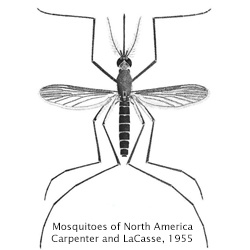Exploring Mosquito Species
Continuing the theme of mosquitoes of diminutive stature, this month we focus on another small mosquito – the tiny and mighty Culex erraticus.
 In contrast to the beautiful, benign Uranotaenia lowii of last month, Culex erraticus is dressed more plainly in rich chocolate brown from proboscis to toe with lighter tan banding on the abdomen. Their size is not to be underestimated; they come equipped with a long proboscis with the business end being swollen. Their bite is regarded as painful, with the added insult of being accompanied by a vector-borne disease at times. Even though sorting through great masses of tiny brown mosquitoes quickly becomes monotonous, these tiny mosquitoes are of great interest to mosquito management programs due to their appetite for birds, large hooved mammals, reptiles, amphibians, and humans.
In contrast to the beautiful, benign Uranotaenia lowii of last month, Culex erraticus is dressed more plainly in rich chocolate brown from proboscis to toe with lighter tan banding on the abdomen. Their size is not to be underestimated; they come equipped with a long proboscis with the business end being swollen. Their bite is regarded as painful, with the added insult of being accompanied by a vector-borne disease at times. Even though sorting through great masses of tiny brown mosquitoes quickly becomes monotonous, these tiny mosquitoes are of great interest to mosquito management programs due to their appetite for birds, large hooved mammals, reptiles, amphibians, and humans.
Unlike the last few stars of the Mosquito of the Month blog, Culex erraticus behaves a little more predictably to the benefit of mosquito control programs. Gravid females (mosquitoes preparing to lay eggs) fly in search of a blood meal at dusk and dawn, often in great numbers, and respond well to the carbon dioxide baited light traps utilized by surveillance programs. Due to their fairly indiscriminate feeding habits, they have tested positively for eastern equine encephalitis (EEE) virus, St. Louis encephalitis (SLE) virus and West Nile virus (WNV), as reported by the CDC. Luckily (if you can count the exception as lucky), these mosquitoes have only been found to be competent vectors of eastern equine encephalitis virus, and don’t seem to effectively spread the other viruses they have been infected with.

Perhaps to make up for what small space they occupy individually, their range covers a huge swath of land. In the United States, they have been found in mosquito control traps as far north as New Jersey and as far east as Texas, and in every country between our southern border and Peru, with several vacationing on Caribbean islands. Their range focuses around the swampy areas used as their larval habitat. Adult females, after having a blood meal, lay translucent eggs clustered together tightly in a structure called an egg raft that floats atop the water until the eventual emergence of larvae. Culex erraticus larvae bear something of a resemblance to their adult form as far as their coloration goes – they’re chiefly brown with a noteworthy light brown base to their antennae. Once having emerged as adults, they do not stray very far from their swamp, to the benefit of mosquito control.
Though they do not provide the most exciting find in the surveillance lab, these tiny chocolate mosquitoes are a wealth of information to any surveillance program.
Contact Us to Learn More About Effective Mosquito Management Strategies:
 Since 1992, Vector Disease Control International (VDCI) has taken pride in providing municipalities, mosquito abatement districts, industrial sites, planned communities, homeowners associations, and golf courses with the tools they need to run effective mosquito control programs. We are determined to protect the public health of the communities in which we operate. Our mosquito control professionals have over 100 years of combined experience in the field of public health, specifically vector disease control. We strive to provide the most effective and scientifically sound mosquito surveillance and control programs possible based on an Integrated Mosquito Management approach recommended by the American Mosquito Control Association (AMCA) and Centers for Disease Control and Prevention (CDC). VDCI is the only company in the country that can manage all aspects of an integrated mosquito management program, from surveillance to disease testing to aerial application in emergency situations.
Since 1992, Vector Disease Control International (VDCI) has taken pride in providing municipalities, mosquito abatement districts, industrial sites, planned communities, homeowners associations, and golf courses with the tools they need to run effective mosquito control programs. We are determined to protect the public health of the communities in which we operate. Our mosquito control professionals have over 100 years of combined experience in the field of public health, specifically vector disease control. We strive to provide the most effective and scientifically sound mosquito surveillance and control programs possible based on an Integrated Mosquito Management approach recommended by the American Mosquito Control Association (AMCA) and Centers for Disease Control and Prevention (CDC). VDCI is the only company in the country that can manage all aspects of an integrated mosquito management program, from surveillance to disease testing to aerial application in emergency situations.

